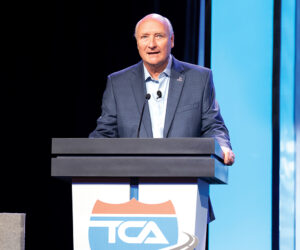If only it had been the lottery.
You may recall that in the November 1-15 issue, we made a prediction that when the American Transportation Research Institute issued its “Critical Issues in the Trucking Industry – 2018” survey on October 29 during the American Trucking Associations’ management Conference and Exhibition, that the top three concerns within the driver audience would be the same as in 2016 and 2017: Hours of Service, truck parking and the ELD mandate.
Sure enough, that was the case.
Cha-ching.
We’re waiting for the quarters to come pouring out of our desktop.
The order may have changed from year to year, but the issues did not.
Of course, as we reported in our Page 1 story in this issue, there were some disparities among the responses of professional truck drivers, motor carrier executives and other trucking industry stakeholders, the two larger audiences for the survey (drivers and executives accounted for about 90 percent of the respondents).
Truck parking was the most blatant disparity.
Drivers rated truck parking as the No. 2 issue, the other two audiences rated is No. 9.
For each of the top 10 issues listed, there were three strategies for dealing with that particular concern.
Here are the strategies for truck parking, which ranked No. 5 overall:
- Identify strategic locations on the National Freight Network for new or expanded truck parking because of increased traffic congestion and industry/regulatory changes. A majority of survey respondents (50.2 percent) have indicated that identifying strategic locations to expand truck parking capacity is their preferred strategy for addressing the pervasive shortage of truck parking. In particular, re-opening shuttered parking facilities and investing in new facilities are the most direct strategies aimed at alleviating the chronic and growing shortage of truck parking.
- Educate the public sector on the safety consequences that result from closing public parking facilities and/or failing to expand truck parking availability. The Jason’s Law Report first brought attention to the safety risks commercial drivers face as a result of the truck parking shortage, and more recent research continues to quantify the safety impacts of an inadequate supply of truck parking. ATRI’s truck parking diary research quantified the frequency in which drivers are forced to park in undesignated or unauthorized truck parking locations like highway shoulders or on-ramps, with 48.7 percent of drivers reporting that the parking shortage leads them to do so between three to seven times per week. As such, this is the preferred strategy for 38.2 percent of respondents, up from 29 percent in 2017, as a growing number of industry stakeholders hope that educating state and local officials on the critical need for safe truck parking facilities could lead to new investments.
- Research the role and value of real-time truck parking information availability and truck parking reservation systems. Leveraging technological advancements to develop real-time truck parking solutions was the preferred strategy for a small, but growing percentage of respondents. The share of respondents selecting this strategy increased from 7.2 percent to 11.7 percent, reflecting the considerable public sector interest and investment in these systems.
Driver retention was No. 3 overall issue and on the subject of recruiting and retention, the survey mentioned that many carriers have (some more than once this year) increased compensation packages for drivers, including salary, bonuses and benefits.
We wondered if the compensation increases were attracting new drivers and just causing a churn in the existing driver pool, knowing among large truckload carriers, the turnover rate is almost 100 percent.
We turned to Rebecca Brewster, president and COO of ATRI for the answer.
“The question of whether increases in compensation packages leads to more entrants to the industry or just exacerbates churn is difficult to quantify but at the end of the day, the driver is coming out on the winning side of that equation whether experienced or new entrant as we see increases in sign-on, retention and driving performance bonuses as well as wages and benefits,” she told us.
Let’s hope these enhanced benefits packages will entice new entrants.
Lyndon Finney’s publishing career spans over 55 years beginning with a reporter position with the Southwest Times Record in Fort Smith, Arkansas, in 1965. Since then he’s been a newspaper editor at the Southwest Times Record, served five years as assistant managing editor of the Arkansas Democrat-Gazette in Little Rock and from November 2004 through December 2019 served as editor of The Trucker. Between newspaper jobs he spent 14 years as director of communications at Baptist Health, Arkansas’ largest healthcare system. In addition to his publishing career he served for 46 years as organist at Little Rock’s largest Baptist church.








